From Cape Town we headed north to the wine country of Stellenbosch. We are not nearly refined enough to appreciate it fully, and Keith is not big on wine anymore (thanks to the Newport Wine Festival!), so we put in a rather short appearance. We did walk away with a couple bottles of vino and saw some beautiful countryside and estates.
From there we pushed north up the N7 in search of the famous flower bloom of Namaqualand. The area 200-300 km north of Cape Town is an arid, dry place that springs to life with wildflowers after the first rains of the year. As the brochures and guidebooks say, the ground is carpeted in color. The flowers don't last long and the timing of their arrival obviously varies from year to year depending on the weather. We had heard it was worth seeing so we had sort of planned our movement through South Africa around it, hoping Mother Nature would work with our schedule. We did some asking around as we neared CapeTown and learned the flowers were early this year and that they were having one of the best years ever. Now we were worried we would be late, but it all turned out beautifully.
Our first night in flower country we stayed in Clanwilliam and walked around a semi-groomed wildflower garden. The next day, we headed further north towards Springbok and on that stretch of road is where the real show started. Just driving along the highway, you are treated to wonderful displays of color - mostly orange and purple. We stayed that night in a small town called Kamieskroon which is the closest town to the Namaqualand National Park where some of the most dramatic displays are seen. So we spent that afternoon and the next morning strolling around the never-ending fields of orange.
To get to Springbok, we took a back road/dirt road out of the park and were treated to even more spectacular views. We also got to really use the Land Rover for what it is intended and helped a stranded family get their 'bakkie' across a river bed. We camped in Springbok that night and woke to....guess what? Rain! A very light, misty rain, but good thing we saw the flowers when we did as those little guys weren't going to be opening up on such a grey day. Here are just two of the at least 100 photos we took of flowers. We enjoyed playing with the macro function on our camera, but I'm sure some of our friends out there (John G., Linda S.) would put us to shame with their photographic ability. Despite our amateurism, I think we got some nice shots regardless.
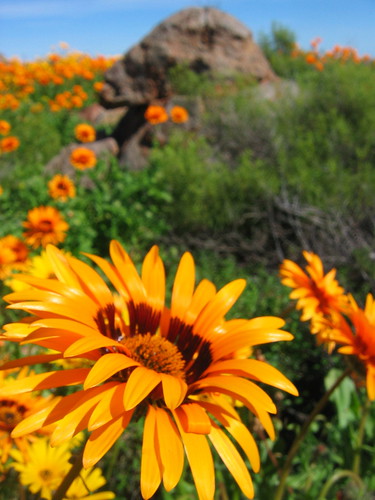
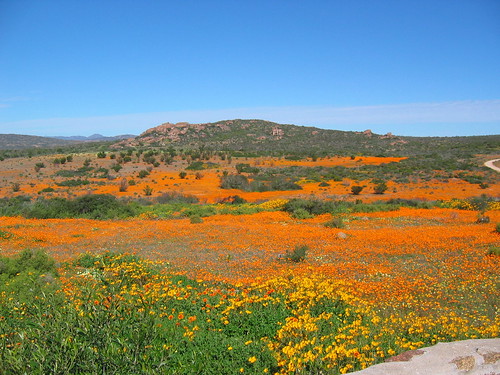
From Springbok, we headed East across dry, flat country and a very straight road until we got to Augrabies National Park. This is an arid region with the park set around a spectacular gorge. The Orange River runs through this gorge and it produces the worlds 6th largest waterfall (by what measurement we aren't sure). It was pretty dramatic to say the least, but apparently during the rainy season it flows at 30 times more volume than what you see in this photo. We did a short nature trail around the area and had a lazy day at camp, and guess what? It rained again! And we thought we were in the dry country now. Oh well, it was a hard rain, but only a short one.
Augrabie Falls:
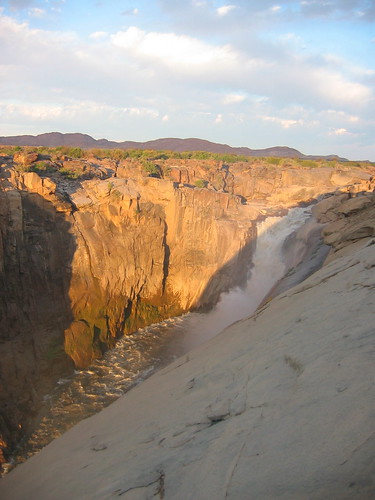
From the park we stopped in Upington to do some random business before saying good-bye to South Africa for a while.
So....onto Namibia.
We have learned very quickly that traveling through Namibia is going to involve much longer days in the car. The distance between sights and towns is so far! Namibia has one of the smallest populations per square kilometer in the world. We believe it.
The first day we drove and drove and drove, through a sleepy border crossing, and into the Fish River Canyon region. We stayed the first night at the end of the great Fish River Canyon (which they compare to the Grand Canyon and although I haven't been to the Grand Canyon, I think the comparison is a stretch) and camped at Ais Ais, where they had a very welcome hot spring pool to help wash some of the dust off. The next day we went north to the beginning of the canyon, Hobas, which turned into a short stop as you are forbidden to do any day hiking down into the canyon. So we just stopped, admired the views and picked up a kooky Italian couple who needed a ride. The very short ride they asked for, turned into a much longer one and we had company camping that night at a very random and completely isolated spot called Naute Dam where we camped for free, and shared a lovely pasta dinner and bottle of wine.
A look into Fish River Canyon:
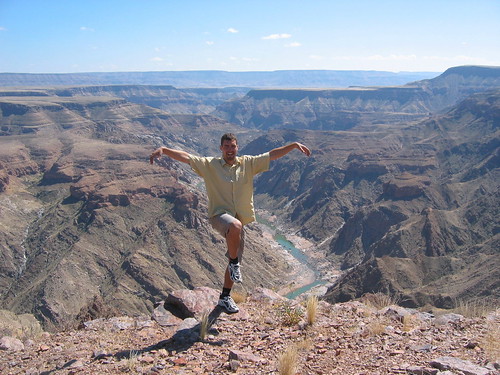
Pina and Alberto stayed with us all the way to Luderwitz which is a small fishing community on the coast. Namibia was originally settled by Germans, so a lot of the towns we will be passing through will have a bit of a German feel to them. Luderwitz is one of them and has some interesting buildings and is also close to the ghost town of Kolmanskop, a deserted German town that was built when diamonds were discoverd in the area. It has since been abandonded as there were greater diamond deposits found further south, so now it is a popular tourist destination as the sand reclaiming the buildings makes for an interesting sight.
Here is Keith in one of the many buildings. He looks like a giant!
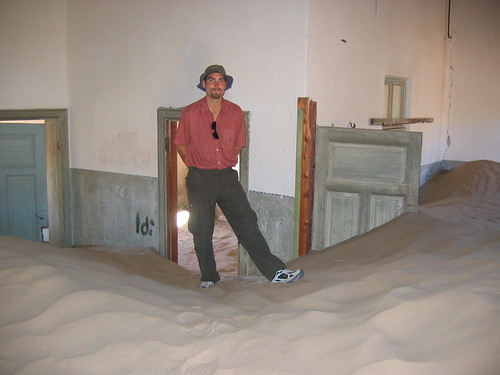
We left our Italian friends in Luderwitz, but now were sort of caravaning with another couple that we met at the backpackers in Luderwitz, Inge and Rob. We drove the backroads with them as we made our way north towards Sesrium and the great red sand dunes of Namibia one of THE tourist stops. Along the way, we found one of the most fantastic campgrounds we have stayed in yet. It was called Namtib Lodge and Camp and had a perfect desert setting - red rocks behind, open plains in front and a fabulous African sky for star gazing at night. So peaceful and so pretty. We scrambled to the top of the red rocks to watch the sunset, then had a nice evening around the campfire.
Along the scramble to the top of the rocks:
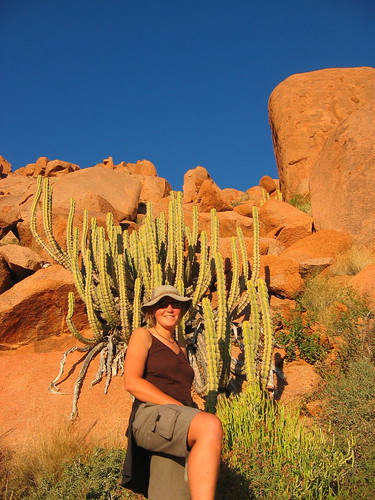
The next day we made our way into Sesrium and again shared camp with Rob and Inge. Keith and I went out to the closest dune and watched the sunset with a hoard of other tourists. The sunset wasn't all that great, but the colors it splashed on the surrounding landscape was fantastic. Sesrium sits about 65 km west of the main attraction which is Soussevlei, where the dunes are closer together, higher and more picturesque. The big thing to do, is to get up at 5:00 AM, and drive out to Dune 45 (45 km out) and watch the sunrise. We knew it would be an overrated endeavor, but what the heck. As for sunrise, they don't really open the gate in time for you to actually get to dune 45 in time to see the sunrise proper. But the early morning color you get for the hour after sunrise is definitely worth the early morning wakening. We stopped at Dune 45 (which is really only popular because it is close to the road and closer to camp than Soussevlei), took a few pictures then drove out to the end of the road. We spent the next couple hours wandering around and up and down the dunes. Really impressive and really beautiful. We took tons of pictures of course, but only a couple will make it up today.
Us on top of a dune at sunset.
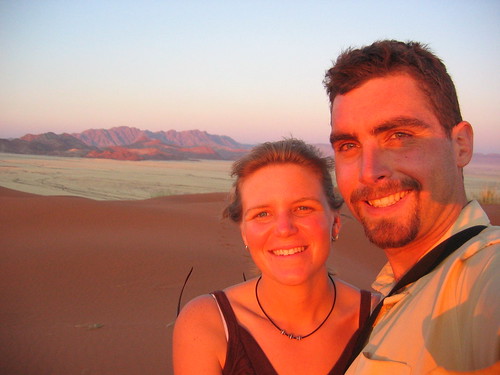
This one was taken out in the Soussevlei area.
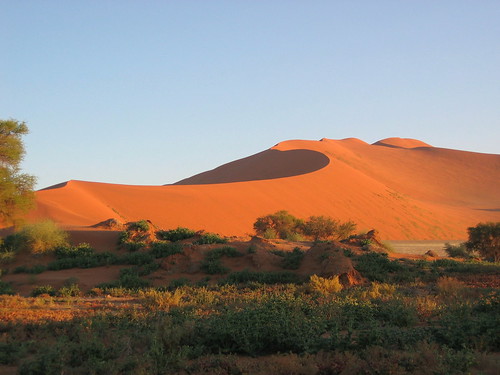
For as flat as Namibia is, there are still plenty of mountains. So we decided to go into them a little bit. From Sesrium, we headed to the Naukluft Mountains. We were only 1 km from the road into the park, when we hear a very suspicious whooshing sound out the window. Big 'ol flat tire. No problem changing it, and we finally got into camp, hot, dusty and exhausted (this hot weather driving stuff can wear a person out!). We had a lovely camp setting right on a very small river with lots of trees and pretty much just kicked back the rest of the night. To explore this area we did a 17 km day hike up a river bed, over a canyon and down another river bed. We were lucky enough to have a breezy day and as the nights are cold here, and we started early, we actually were cold for most of the hike. A very pleasant hike, and we were out in time to drive all the way into Windhoek, the capital of Namibia. Yes, back on paved roads and back into civilization.
Flat tire and a look at the typical Namibian road.
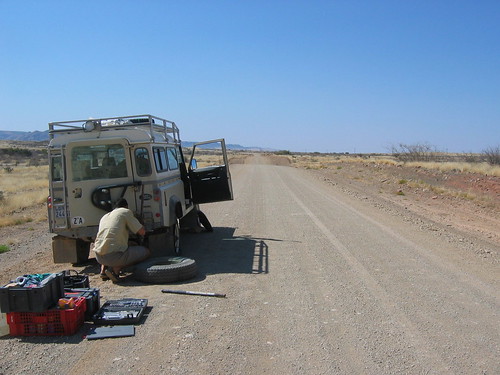
And so here we are. Cleaning the dust off of everything, washing clothes, shopping and getting the tire repaired. We hope to set off tomorrow and will head back to the coast to a place called Swapkomund. I wish I could post more pictures for you, we have lots of really nice ones, but it's hard to find places that let me change the size of the photos, and with large photos, it makes for a slow upload. We'll try to post again soon, but don't be surprised if it doesn't happen until we are back in Pretoria!
One more thing....
CONGRATULATIONS Sarah and Wayne on your new addition! Welcome to the world Tanner!
3 comments:
The flowers. WOW!
That giant in the doorway of the deserted German town. Very intimidating looking. You both have a more seasoned, tougher look, with a lovely light in your eyes, especially in a desert sunrise. Just keep the photos coming they are so interesting and beautiful to see.
CJ
Wow! Those orange flowers are called African daisies and I've had some in my garden. They don't survive the winters here. Gorgeous. I'll want to see all the pictures, of course. (How will we look at all those photos???)
Mom
VEE, VIE, VO, VUM, I schmell SCHOOBIE SCHNACKS! (in my best Deutsch) :-)
Herro again! I noticed some of the names for towns sounded pretty German. I thought it was just my inherited desire to conquer the world speaking but glad you noticed it too :-) Those are great pictures. I look forward to the Full DVD version, it will be quite a show.
Post a Comment